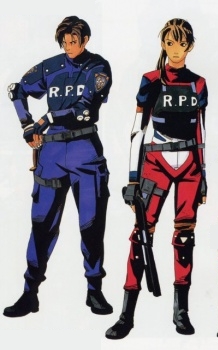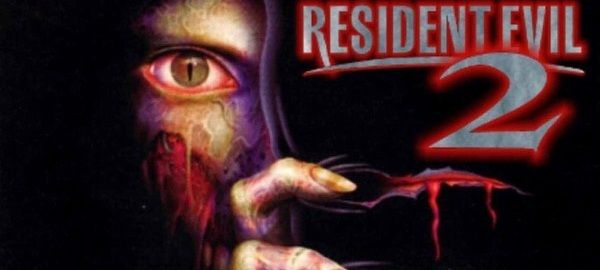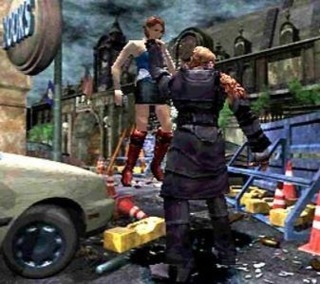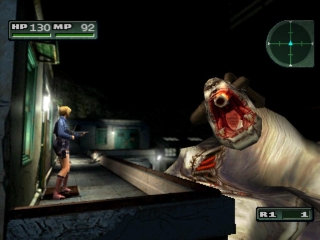
If you’re anything like me, you like to be scared. Horror movies accomplish this nicely from time to time, but for a truly memorable experience, horror games are unmatched. They drop you into terrifying situations, leaving you no choice but to wade through unforgiving environments and do battle with grotesque creatures… but when did this genre begin? How did it evolve? If you find yourself asking these questions, take a seat. Welcome to our domain!
We recently covered the birth of horror games, and then waxed poetic about the genre’s evolution. This time around, you’ll be reading about a far more stable period for this type of game. As certain horror titles began to stand out from the crowd, developers and publishers quickly took notice. This leads us directly into…
The Age of Sequels
 A sequel to Resident Evil dropped in 1998 for the PlayStation, though that wasn’t always the plan. The game was initially going to be released in March 1997 and, had Capcom done so, the current state of the series would look quite different today.
A sequel to Resident Evil dropped in 1998 for the PlayStation, though that wasn’t always the plan. The game was initially going to be released in March 1997 and, had Capcom done so, the current state of the series would look quite different today.
Now referred to as Resident Evil 1.5 by fans, the original vision for the franchise’s first sequel would have seen the dismantling of the dastardly Umbrella Corporation. While rookie cop Leon S. Kennedy was still the male lead (albeit with a different look initially), female protagonist Claire Redfield (sister of Chris from RE1) didn’t exist. In her place was a character named Elza Walker, a university student modeled after Clueless star Alicia Silverstone. The cast of supporting characters was also different, along with the gallery of grotesque enemies and bosses — and one of them might have even been a mutated Albert Wesker.
Capcom’s plan was to create an engine capable of rendering larger enemy groups on-screen, along with dynamic battle damage on skin and clothing. The Raccoon City Police Department would also have actually resembled… well, a real police department.
Instead, Capcom executives made the decision to scale back the scope of the project and bring in more ties to the original game. Umbrella was resurrected, Claire was created, and all other characters were either scrapped or repurposed. It was during this stage when the iconic Lickers were added to the game, and the RPD building was made to resemble a renovated museum.
Thus, one year later than originally planned, Resident Evil 2 was released to critical acclaim. Troubled though its development was, gamers would have never guessed based on its immense quality. Hell, we were just amazed that it featured four playable Scenarios thanks to the awkwardly-named “Character Zapping” system. While it still sounds odd, the application of the Character Zapping system was actually quite revolutionary for the time.

Players loaded up Scenario A as Leon (for example), and certain actions or decisions could be made at key points. Whether it’s choosing to leave a weapon in the locker you found it in, or scanning your thumbprint into a computer. These choices would then alter Scenario B, which you could load up after A’s credits rolled. Claire would be able to grab the weapon left for her in that locker, and could also gain access to a secret boss thanks to Leon’s actions with the computer.
As if that wasn’t already a generous amount of content, both Scenarios could be played as either character.
Scenario B also featured Capcom’s first attempt at mimicking Clock Tower’s Scissorman, taking the form of Mr. X in RE2. This large, imposing enemy with his dead-eyed stare and strange trenchcoat would show up at inconvenient times. He could not be permanently defeated until the final encounter, though his meandering stride and slow attacks were only a warm-up for what was to come later in the series.
Meanwhile, Clock Tower II: The Struggle Within also hit retail shelves in 1998. This entry is mostly regarded as a mere spinoff by most fans, as it had little to do with the others entries within the series. While the gameplay was mostly unchanged from the previous Clock Tower game, The Struggle Within’s subtitle seemed to accurately portray the mindset of the developers. Partway through the game, the experience began to diverge from the traditions and spirit of its predecessors, eventually concluding with a few action set-pieces where the playable characters could wield guns — which, up to that point, had been a bit of a taboo for these games.
 Resident Evil 3: Nemesis launched in 1999, and was the final numbered RE title released for PlayStation. While much of the gameplay remained unchanged from RE1 and RE2, several key features were added. First and foremost, an Easy Mode was selectable from the very beginning. This gifted gamers with an infinite assault rifle with which to mow down the undead hordes of Raccoon City… and something else.
Resident Evil 3: Nemesis launched in 1999, and was the final numbered RE title released for PlayStation. While much of the gameplay remained unchanged from RE1 and RE2, several key features were added. First and foremost, an Easy Mode was selectable from the very beginning. This gifted gamers with an infinite assault rifle with which to mow down the undead hordes of Raccoon City… and something else.
As Capcom opted to forego tradition this time, RE3 upgraded Jill Valentine to the status of sole protagonist. While mercenary Carlos Oliveira is also playable at specific intervals, this time around there was but one story to play through. As Jill tried desperately to escape Raccoon City in a timeline which ran concurrent to RE2, she found herself hunted by Umbrella’s deadliest creation yet: Nemesis.
Serving as Capcom’s attempt to outdo Clock Tower at their own concept, Nemesis was a large, hulking monstrosity with a lightning-fast sprint and handy rocket launcher. Charged with tracking and killing all S.T.A.R.S. members, he pursued Jill throughout the entire game — chasing her from room-to-room, crashing through windows, and dropping in from ceilings without warning. Though he could be temporarily defeated at the cost of precious ammunition, most gamers had little choice but to flee and hope he fell behind.
This not only made RE3 the most intense Resident Evil at that time, but also continues to lend it some notoriety to this day. As if Nemesis at his most basic form wasn’t terrifying enough, he experiences multiple mutations throughout the game — helping him to make more use of his long, gnarly tentacles. This culminates in a final showdown at the end of the story, and no villain in the history of gaming has brought me more joy whilst they experienced their final death throes.
While Nemesis was indeed RE3’s key feature, there are other gameplay mechanics worth noting. A rudimentary dodge function was included, allowing Jill to sidestep attacks — though its requirements for activation left players scratching their heads. At specific story moments, Jill was also faced with decisions which paused gameplay, however briefly. The player’s choices altered the ending of the game, but could also lead to more immediate consequences, such as death or the start of an avoidable boss battle. My favorite new feature, however, has always been the ammo creation mechanic, wherein different kinds of gunpowder can be mixed to make various types of ammunition. I’ll never understand why that was left out of future sequels…
 Parasite Eve II dropped in 1999 as well, bringing with it an overhauled gameplay style. Designed as less of a RPG and more of an action game, Aya’s attacks were no longer at the mercy of an active time battle system, meaning she could fight in real-time. Random encounters were dropped in favor of littering environments with visible foes, and since Aya’s weapons were no longer limited to a specific range, she could shoot targets off-screen for more survivability.
Parasite Eve II dropped in 1999 as well, bringing with it an overhauled gameplay style. Designed as less of a RPG and more of an action game, Aya’s attacks were no longer at the mercy of an active time battle system, meaning she could fight in real-time. Random encounters were dropped in favor of littering environments with visible foes, and since Aya’s weapons were no longer limited to a specific range, she could shoot targets off-screen for more survivability.
The plot further advanced Aya’s career, seeing her take a job as an FBI Agent tasked with dispatching freaks for a living. Genetics also played into this story, with Aya encountering what was, essentially, her daughter — a new Eve, created by scientists using Aya’s DNA. This took things in a much more cerebral direction… but not quite as much as the next game.
The Birth of Psychological Horror
While Konami is largely despised by players (and many developers) today, they were a major force in gaming’s early days. The Castlevania series figured prominently in the first part of our horror history, but Contra, Frogger, and even Gradius made Konami beloved by the masses. For myself, it wasn’t until they created a very special game that I came to know of them: Silent Hill, released in 1999 for Sony’s PlayStation.
From the moment you booted up the game and heard Akira Yamaoka’s unsettling intro theme, you just knew this experience was going to be unique. This extended to all facets of its creation, from the gameplay, to the story, and especially the soundtrack.
Starring everyman Harry Mason, players were put into the shoes of a guy with no combat expertise whatsoever. He wasn’t a cop, nor a federal agent, or even a guy with a history of violence — he was just a dude who was on a road trip with his daughter… until their destinies took a strange turn. As such, Harry felt like one of the clumsiest playable characters in gaming. He swung metal pipes and wooden planks haphazardly, held firearms with an inherent awkwardness, and even stunned himself if he ran into a wall. This immediately took away the sense of empowerment gamers were accustomed to, and allowed a general uneasiness to settle in.
While Resident Evil’s Raccoon City simply felt like a location, the town of Silent Hill was truly a character all its own. In the game’s opening moments, it lulled you into a false sense of security with an overwhelming calm — even as Harry tried dearly to track down his daughter. An unending fog silently enveloped the town, and while you may not notice at first, it filled you with a sense of dread right away. Am I headed in the right direction? Did something move up ahead? When is this fog going to let up? These are just a few of the questions you asked yourself in the first several minutes, up until you see Harry funneled down a darkening alleyway as even the camera betrayed you… and the rest, as they say, is gaming history.
What followed was a tale of horror, suspense, puzzles, gore, and psychological trauma the likes of which gamers had never experienced before. While Resident Evil may have been the culmination of the genre’s gameplay mechanics, Silent Hill was the ultimate evolution of its principles. Never are you allowed much confidence during this hellish roller coaster of emotions, always left off-balance and second-guessing your next move. It truly disturbs you deep down, something accomplished in so small part by the amazing soundtrack. Those industrial sounds and ominous effects, like the dreaded air raid siren, somehow trigger your adrenaline more than the plentiful demons you’ll encounter.
Resident Evil may be my favorite series overall, but Silent Hill is the one I respect the most — even in the face of later missteps. Without this first game showing us how deeply a video game could root itself in our psyches and unfurl its story like modern legend, this genre would not be what it is today. As we bid farewell to the PlayStation and Nintendo 64, a new wave of consoles ushered in yet another generation of horror… and the nightmare lived on.
UPDATE: Part Four of “It’s In Your Blood: A History of Horror Games” is now available!







